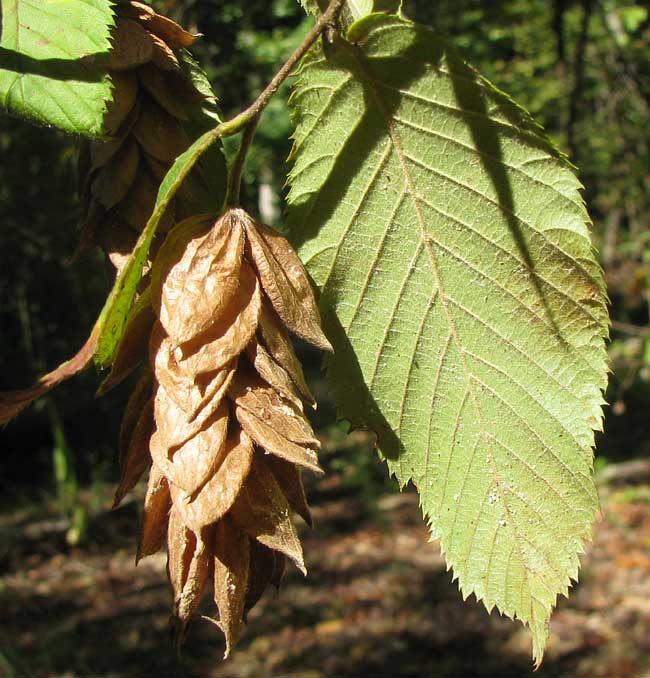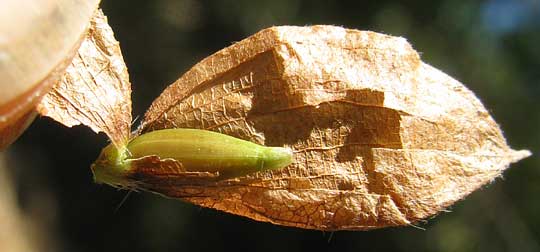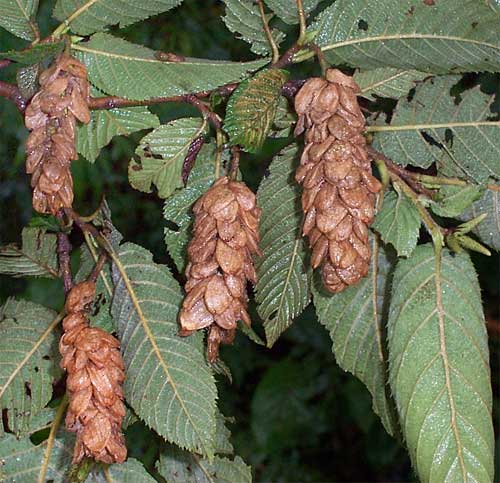Excerpts from Jim Conrad's
Naturalist Newsletter

from the October 25, 2009 Newsletter, from near Natchez, Mississippi
HOPHORNBEAMS
Above you see leaves and a fruiting head of the Hophornbeam, OSTRYA VIRGINIANA. Earlier this species also resided in the Hazelnut Family but now usually it's assigned to the Birch Family. You can see that though its leaves are very similar to the Hornbeam's its fruiting heads are different in that instead of downward slanted flat bracts they hold flatish bladders, like squashed Chinese lanterns. An open bladder is shown below:

The yellow-green item inside the bladder is the fruit, a nut. Therefore, the fruiting head actually is very similar to that of the Hornbeam's, except that the Hophornbeam's bracts surround the nut instead of simply spreading above it.
As with the Hornbeams, Hophornbeams are understory trees distributed throughout most of North America's Eastern Forest Biome. Because Hophornbeam leaves are so similar to Hornbeam leaves, students sometimes confuse the two species. The Hophornbeam's bark is pale ashy gray and flaky, however, very different from the smooth, slate-gray bark of the Hornbeam.
Where does the "hop" come from in Hophornbeam? If you've seen fruiting heads of the Hop vine used in brewing beer you already know.
from the February 15, 2009 Newsletter, from near Natchez, Mississippi
PURPLE FINCHES EATING HOPHORNBEAM SEEDS
Despite this week's rains, a couple of times the open crowns of our larger hophornbeams have been busy with Purple Finches, CARPODACUS PURPUREUS. A flock of maybe ten of these sparrow-size birds with their short, thick, seed-cracking beaks would wheel out of the sky and form a loose flock inside the tree, each bird then setting about visiting one fruiting cluster after another. They'd rip into a bladder, perch for a moment as they'd grind the seed and swallow it, then instantly move to the next meal. Up close I could hear the birds' soft, sharply metallic notes. Their intense foraging would continue for half an hour or so before suddenly the flock would take to the sky and disappear.
Hophornbeam is not at all one of the Purple Finch's preferred foods. Above all things, Purple Finches adore the seeds and buds of elms, the winged fruit of Tuliptrees, the buds of fruit trees, redcedar fruits, buds and fruits of maple, fruits of ash, Sweetgum, ragweed, cocklebur, and a lot of other things that are NOT hophornbeam seeds. However, now in mid February it's too early for the elm's fruits and plump buds, but fall's Tuliptree, maple and ash fruits are long gone, and the ragweeds and cockleburs of that season now have been picked clean, their herbaceous stems dark, pithy, and collapsed onto the ground.
Fact is, nowadays Purple Finches are feeling the food crunch that comes for so many animals at this time of year. Now many animal species are having to take a second look at foods that just a few weeks ago they passed by.
from the November 5, 2007 Newsletter issued from Yerba Buena Clinic just outside Pueblo Nuevo Solistahuacan, Chiapas, MÉXICO
about 1740 meters in elevation, ± LAT. 17° 11' 27"N, LONG. -92° 53' 35"W
A LUSTY HOPHORNBEAM
Surely the most fascinating feature of our Pine-Oak-Sweetgum forest is its high percentage of relict species that are identical to, subspecies of, or sister species of, species typical of the forests of eastern North America, Sweetgum being the most conspicuous.
For example, take a look at the sodden tree branch below:

You may recognize the clusters of flattened, leafy, hoplike bladders as fruits of the Hophornbeam, genus Ostrya. However, have you ever seen such long fruit clusters? And the leaves don't look quite right, either. Studies done here don't list any Ostryas so I don't know if this is considered a relict Eastern Hophornbeam, or a different species.
How interesting yet how frustrating to be living amid all this but not have fieldguides or decent Internet access so I can figure it all out!